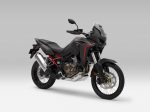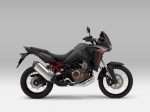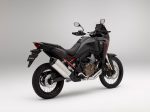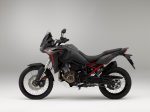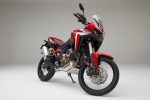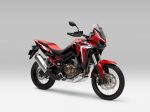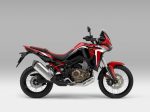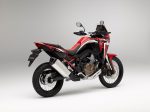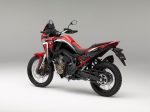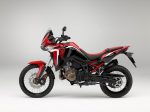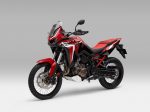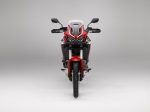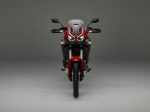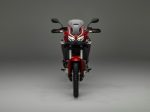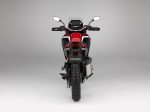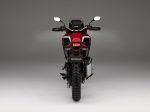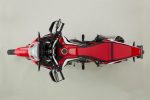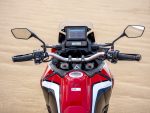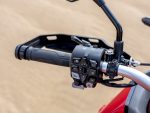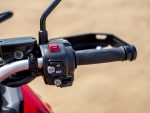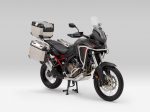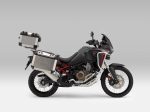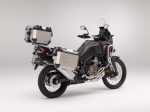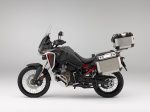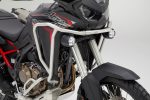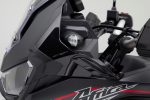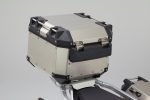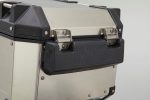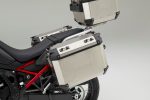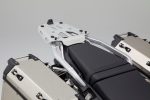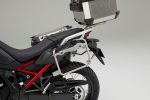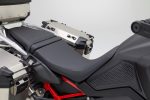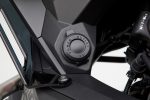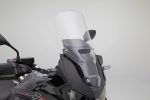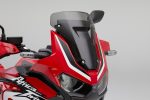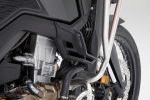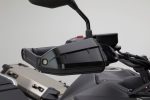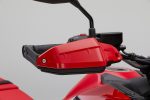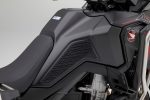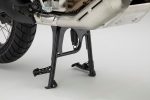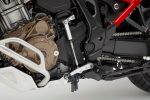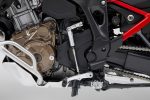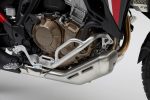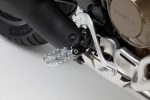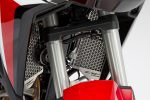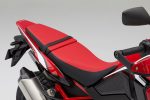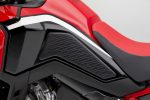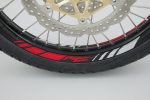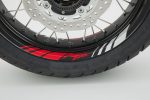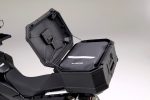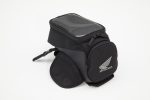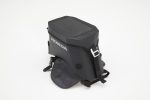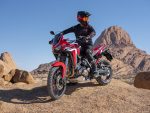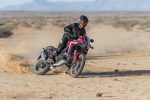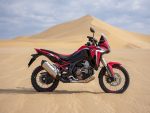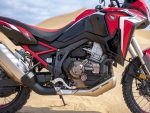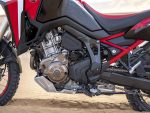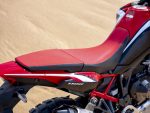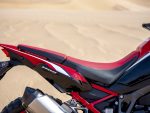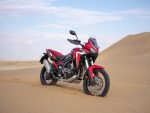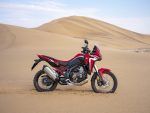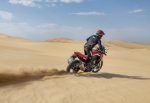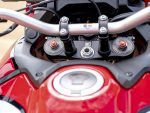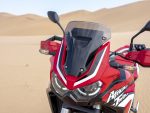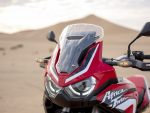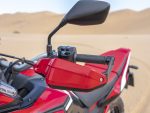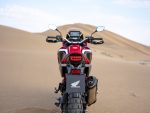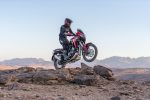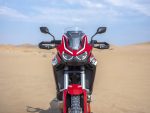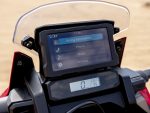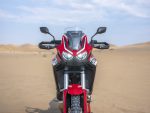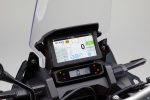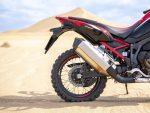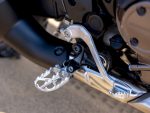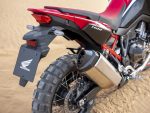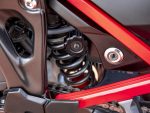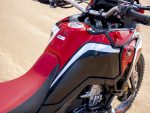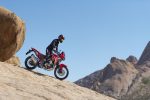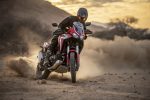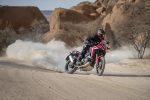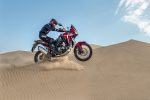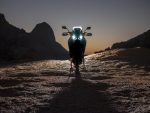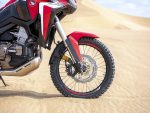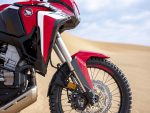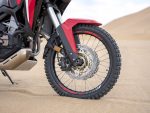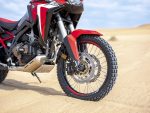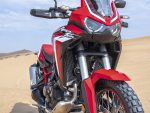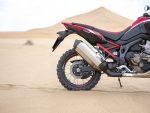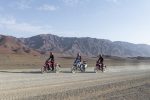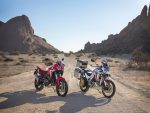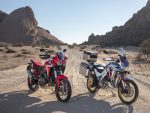– Buyer’s Guide: 2020 Honda Africa Twin 1100 Review / Specs + New Changes Explained with R&D Info –
The 2020 Honda Africa Twin 1100 is here and it came out with a bang! If you follow the blog or have been on the internet for the last year then you probably knew it was coming but now we finally know all of the nitty-gritty details on the 2020 Africa Twin 1100 VS 2019 Africa Twin 1000 changes etc. So today, we’re going to do a deep dive and jump in on just the “base” model Africa Twin 1100 models, including the DCT but not the Adventure Sports ES versions as I’m saving that detailed breakdown for the post coming up right after this one. I do touch on some of the differences between them below but like I said, the deep dive will be coming up shortly.
What all did Honda change for 2020 on the Africa Twin? A lot! Here’s a quick teaser at what was changed and what we’ll be going over in more depth below: lighter chassis, slim rally-style bodywork and revised riding position, weight is reduced, engine capacity is increased bumping up the horsepower and torque. It’s also EURO5 compliant. A six-axis Inertial Measurement Unit borrowed from the CBR1000RR now manages riding modes and HSTC as well as three additional systems – Cornering ABS, Wheelie Control, Rear Lift Control, plus new cornering detection functionality on the DCT version. A full color 6.5-inch TFT touchscreen incorporates Apple CarPlay® and Bluetooth connectivity. Dual LED headlights feature Daytime Running Lights (DRL) and cruise control is fitted as standard. In short, Honda went to work for 2020 and thankfully did a lot more than just throw new color schemes on it and say here you go.
Here are the key highlights for those that are just looking for one certain piece spec on the 2020 Africa Twin 1100 / CRF1100L:
Key 2020 Africa Twin 1100 Info / Specs (for those in a hurry):
- 2020 Africa Twin Model Options / Variations:
- Option 1: Africa Twin 1100 with Manual Transmission (Model ID: CRF1100L)
- Price / MSRP: $14,399
- Option 2: Africa Twin 1100 with DCT Automatic Transmission (Model ID: CRF1100LD)
- Price / MSRP: $15,199
- Option 3: Africa Twin 1100 Adventure Sports ES with Manual Transmission (Model ID: CRF1100L4)
- Price / MSRP: $17,199
- Option 4: Africa Twin 1100 Adventure Sports ES with DCT Automatic Transmission (Model ID: CRF1100L4D)
- Price / MSRP: $17,999
- Option 1: Africa Twin 1100 with Manual Transmission (Model ID: CRF1100L)
- 2020 Africa Twin 1100 Release Date – March 2020
- 2020 Africa Twin 1100 Colors – Matte Black Metallic
- 2020 Africa Twin 1100 Adventure Sports ES / DCT Colors – Pearl Glare White / Blue
- 2020 Africa Twin 1100 Horsepower – 101 HP @ 7,500 RPM
- 2020 Africa Twin 1100 Torque – 77 ft/lb @ 6,250 RPM
- 2020 Africa Twin 1100 Suspension Travel – FR 9.1 in. / R 9.4 in.
- 2020 Africa Twin 1100 Ground Clearance – 9.8 in.
- 2020 Africa Twin 1100 Fuel Tank Capacity – 5.0 gal. (Adventure Sports 6.5 gal.)
- 2020 Africa Twin 1100 MPG – TBA
- 2020 Africa Twin 1100 Weight – 501 lbs (DCT 524 lbs) (curb weight)
- 2020 Africa Twin Adventure Sports – 530 lbs (DCT 553 lbs) (curb weight)
- 2020 Africa Twin 1100 Seat Height – 33. 7 in. / 34.3 in.
- 2020 Africa Twin 1100 Changes – Yes, briefly mentioned above and explained below.
- * All USA specs above. Different colors are available in different countries.
2020 Africa Twin 1100 Overview of Changes / Features (pictured below)
2020 Africa Twin 1100 Adventure Sports ES Overview of Changes / Features (pictured below)
- 2020 Africa Twin 1100 / CRF1100L Page Contents:
- 1. | Introduction
- 2. | Model Overview
- 3. | Key Features
- 3.1 | Styling & Equipment
- 3.2 | Engine
- 3.3 | Engine & Chassis Management Electronics
- 3.4 | DCT / Dual Clutch Transmission
- 3.5 | Chassis
- 4. | Accessories
- 5. | Pictures / Photo Gallery
- 6. | Technical Specifications
It’s been over three decades since the Honda XRV650 Africa Twin first rolled off the production lines and while the motorcycle that now bears its name – launched in 2016 as the Africa Twin CRF1000L – was a brand-new machine from the wheels up, it fully inherited the essence and spirit of what made the original so popular.
It was the balance between power and weight that was at the heart of the original bike’s appeal, just as it was for the new model. With its unique, athletic appearance, an enjoyable, usable engine and capable, comfortable chassis, the Africa Twin CRF1000L proved itself a true modern-day all-rounder and has been hugely popular with round-the-world adventurers, around-town commuters and weekend tourers alike.
2018 saw the Africa Twin, in both manual transmission and Dual Clutch Transmission (DCT) form, receive Throttle By Wire (TBW) control plus 3 riding modes, expanded Honda Selectable Torque Control (HSTC) options, as well as intake and exhaust development for improved engine response and sound. The platform also expanded: the Africa Twin Adventure Sports – with the same updates but featuring improved wind protection, greater tank range and longer-travel suspension – extended the machine even further into long-range off-road territory.
Building on strong global demand for both models, with over 87,000 sold worldwide since its 2016 relaunch, 2020 is set to be a landmark year for the Africa Twin 1100.
In 2020, you still have (2) different Africa Twin 1100 models to choose from and both vary quite a bit in what features they offer you and then of course you have the option of going with a manual transmission or DCT automatic transmission as well. Here’s a quick highlight of the features between both models:
The touring comfort, technology and ability of the new 2020 Africa Twin 1100 Adventure Sports* are further enhanced – and it adds the option of Showa Electronically Equipped Ride Adjustment (SHOWA EERA™). Meanwhile, the Africa Twin CRF1100L itself is comprehensively redrawn with an aggressive, compact rally style and even sharper off-road focus. It also packs more power and torque and is significantly lighter – in keeping with the first principles set out all those years ago. * I’ll be doing a separate deep-dive into the 2020 Africa Twin CRF1100L Adventure Sports model too.
The 2020 Africa Twin CRF1100L has a sharply-renewed focus on off-road core ability, that brings with it the look – and feel – of a true rally machine. Smaller, slimmer and 11 lbs (5kg) lighter, it offers even more athletic performance, thanks also to changes to the engine, which now produces 7% more peak power (101 horsepower), 6% more peak torque and is much stronger everywhere in the rev-range. It’s also EURO5 compliant.
The frame has been completely revised and now features a bolt-on aluminum subframe. The swingarm, too, is aluminum and based on that of the CRF450R motocrosser. And at the center of the Africa Twin, the addition of a six-axis Inertial Measurement Unit (IMU) controls not only the 7-level HSTC but also (new for 2020) 3-level Wheelie Control, Cornering ABS (with off-road setting), Rear Lift Control and DCT cornering detection. An OFF-ROAD setting also joins the URBAN, TOUR and GRAVEL default riding modes.
Tailored for complete control, the riding position features a slimmer-section seat and higher-set handlebars. A full color Multi Information Display (MID) 6.5-inch TFT touch screen offers immersive engagement with the machine’s systems, plus Apple CarPlay® and Bluetooth connectivity. Dual LED Daytime Running Lights (DRL) are highly visible, improving safety, and cruise control is standard-fit.
- Compact body style designed for off-road, with slim seat and high handlebars
- Multi Information Display (MID) 6.5-inch TFT touch screen
- Apple CarPlay® allows use of Apple iPhone® through the MID
- Bluetooth connectivity, Daytime Running Lights (DRL) and cruise control
Aggressive and compact. Two words that sum up the Africa Twin’s taut new rally-style bodywork. And it’s for a reason – to work better off-road. The fixed screen is much shorter than before, to allow for easy scanning of the trail ahead and, while seat height remains 33.7 in. – 34.3 in. (850-870mm), the handlebars now mount 22.5mm higher, giving a more upright riding position and comfortable control, whether standing or seated.
The tail section is slimmer and the seat itself is 40mm narrower, for easier ground reach; its shape has also been carefully contoured to allow easier back and forth movement. Low 825-845mm and high, 875-895mm seat options are also available as accessories.
New dual LED headlights are set higher, deliver a penetrating beam and also feature Daytime Running Lights (DRL) that automatically adjust to ambient light intensity, improving safety, no matter the conditions. Knuckle guards are standard.
The full color Multi Information Display (MID) 6.5-inch TFT touch screen keeps the rider in control of all of the Africa Twin’s systems, with each of the riding modes selectable through the top left of the screen. The MID can also be customized to show various levels of information relative to the riding mode chosen and is easy to use even when wearing gloves.
It also incorporates Apple CarPlay®, allowing use of an Apple iPhone® through the touchscreen. Navigation apps can also be accessed and displayed and via a Bluetooth helmet headset calls can be made or received. The iPhone® itself plugs into a USB charging port on the right of the MID. Hands-free wireless Bluetooth connectivity is also an option for an iPhone® or Android device and all control inputs are made from the left-hand switchgear.
The front and rear indicators have an Emergency Stop Signal function. When braking suddenly over 31mph the hazard lights flash to warn other road users a hard stop is in process. They also auto-cancel; rather than using a simple timer, the system compares front and rear wheel speed difference and calculates when to cancel the indication relative to the situation.
For 2020 cruise control is now fitted as standard, to ease long-distance highway travel.
- Capacity rises to 1,084cc giving 101 peak horsepower ( 75kW) and 77 ft/lb peak torque (105Nm)
- Achieved through a new cylinder head, valve timing and lift, throttle body and exhaust
- Manual transmission ratios and gear material optimized, saving weight
- The muffler now features a variable Exhaust Control Valve (ECV) for improved low-rpm sound and high-rpm performance
The SOHC 8-valve parallel-twin engine’s essential architecture remains unchanged for 2020 but has a larger displacement of 1,084cc, up from 998cc. And as a result peak horsepower goes from 93 HP to 101 HP @ 7,500 RPM with peak torque going from 73 ft/lb to 77ft/lb @ 6,250 RPM. Significantly, the obvious increase in both power and torque makes itself felt from 2,500 RPM all the way through to the redline.
To create the larger capacity, bore remains 92mm but stroke is longer at 81.5mm (from 75.1mm) with compression ratio of 10.1:1. The cylinder sleeves are also now aluminum. Along with other detailed weight savings in the transmission and elsewhere, the manual transmission engine is now 5.5 lbs (2.5kg) lighter (at 146 lbs / 66.4kg) than the previous design, the DCT version 4.8 lbs (2.2kg) lighter at 165 lbs (74.9kg).
Manual-transmission versions of the Africa Twin are once again offered for customers who still enjoy making gear selections themselves, and this gearbox is 5.5 pounds lighter than in 2019. The six-speed manual gearbox uses the same shift-cam design as found on the CRF450R to ensure positive gear changes, and it uses shorter ratios for 2020. The gears themselves are also reshaped and constructed from a stronger material. The aluminum clutch center and pressure plate use “assist” cams to ease shifting (with light lever feel) and “slipper” cams for deceleration and downshifting. The clutch now has a smaller diameter and features reduced spring tension for lighter lever feel.
An optional accessory quick shifter is available to eliminate the need to use the clutch or close the throttle during gear changes. When the shift pedal is operated, the shift rod’s stroke sensor converts that movement into electronic signals, and the system considers ECU information such as vehicle speed, engine acceleration, deceleration condition and gear position in order to determine timing of the fuel-injection interruption, the throttle-valve opening and the ignition timing, thereby lowering the drive load on the transmission gear for shifting.
As before, the 270° phased crankshaft and uneven firing interval create the engine’s distinctive throb and feel for rear wheel traction. The cylinder head however is completely revised, as is the larger diameter 46mm throttle body; the bore and cylinder pitches are also now aligned to create a smooth air intake profile. The ECU setting is new and the injector angle has been modified to deliver a more direct spray into re-shaped twin-spark combustion chambers.
Honda’s SOHC Unicam valve train is a feature of the MX competition-specification CRF450R and the low-set position of the cast camshaft contributes to the compact nature of the cylinder head. For 2020 the valve timing has been optimized and inlet and exhaust valve lift increased to 10.1mm inlet and 9.3mm exhaust (from 9.2/8.6mm).
The Africa Twin’s displacement increase necessitated a review of the entire exhaust system (both its advanced hardware and its highly accurate software), and engineers capitalized on the opportunity to set a world-best standard for environmental compatibility. The muffler features a single inlet and dual outlets, with an Exhaust Control Valve (ECV)—similar to that on the CBR1000RR sport bike—located just downstream of the split, in the main pipe. The exhaust valve closes off the larger pipe at low rpm for a pulsating feel but opens at high rpm so that gases exit through both pipes for improved output.
The dual catalytic converters are more compact, which is possible because generation of a swirl-flow enables the exhaust gases to be evenly applied to those catalyzers’ surfaces. The result is not only reduced power loss, but efficient exhaust-gas purification. The catalytic converters are positioned closer to the center of gravity, contributing to improved handling feel through the centralization of mass.
The crankcases are split vertically; the water pump is housed efficiently within the clutch casing with a thermostat integrated into the cylinder head. Manual and DCT versions of the engine share common crankcases with only minor external differences; the water and oil pumps are both driven by the engine’s balancer shafts.
It’s a semi-dry sump design with in-tank lower crankcase oil storage. This allows a lower pan depth, keeping overall engine height low. As the pressure-fed pump is located within the tank where it delivers its oil from, there is no need for a pressure-feed passage. Secondary vibrations are neutralized by the mutually reciprocating motion of the pistons, while primary inertial and coupling vibrations are cancelled by the use of bi-axial balance shafts.
For 2020 precision of the front and rear balance gears has been improved, allowing removal of their scissor gears; the addition of a crank pulsar ring adds misfire detection, important for OBD2/EURO5 compliance. In addition for EURO5 the 02 lambda exhaust sensors have been replaced with Linear Air Fuel (LAF) sensors in the downpipes to allow for much more accurate measurement of the air/fuel mixture ratio.
The aluminum clutch center and pressure plate use ‘assist’ cams to ease upshifts and ‘slipper’ cams for deceleration and downshifting; the clutch diameter is now smaller and features reduced spring tension for lighter lever feel. The gears are also re-shaped and constructed from stronger material.
- IMU-managed HSTC intervention levels optimized for off-road use
- Wheelie Control features 3 levels and IMU management
- OFF-ROAD joins the default riding modes TOUR, URBAN and GRAVEL
- Two USER modes allow for complete riding modes customization
The Africa Twin’s engine received the benefits of Throttle By Wire (TBW) control in 2018, allowing much finer management of engine output and character as well as expanded Honda Selectable Torque Control (HSTC) for rear tire grip; for 2020 the system has smartly evolved and now works in conjunction with a six-axis IMU *. I’ll dive more into the IMU below in the chassis section and explain its importance in the electronics package.
The system offers 4 levels of power and 3 levels of engine braking. There are still seven levels of HSTC but each level’s amount of intervention has been optimized to work with real-time input (yaw/roll angle and rate) from the IMU. The spacing of the levels has been optimized to allow the rider a finer choice of the amount of rear tire slide for off-road riding. HSTC can also be turned off completely.
Wheelie Control is another new feature. Again, with the IMU measuring pitch angle and rate, and controlling engine torque via TBW, the rider can choose between 3 levels of input. Level 1 allows for intended wheel lift but suppresses any sudden movement. Level 3 stops any front wheel elevation and level 2 is mid-way between the two. Wheelie Control can also be turned off completely.
There are four default riding mode settings: TOUR, URBAN, GRAVEL and OFF-ROAD to cover most riding conditions and situations plus two customizable USER settings. Even within the default riding modes, it’s possible to change some parameters – HSTC between levels 1-7 (plus off), Wheelie Control between levels 1-3 (plus off) and DCT S mode shift pattern levels 1-3.
- TOUR employs the highest level of Power (1), for touring loaded with pillion and luggage plus mid-range Engine Braking (2) with active on-road Cornering ABS.
- URBAN suits wide-ranging riding requirements and uses mid-level Power (2) and Engine Braking (2) with active on-road Cornering ABS.
- GRAVEL delivers the lowest level of Power (4) and Engine Braking (3). Cornering ABS is active with an off-road setting; in this setting, the rear brake ABS cannot be switched off.
- OFF-ROAD uses lower-mid level Power (3) and the lowest amount of Engine Braking (3). Cornering ABS is active with an off-road setting; the rear brake ABS can be switched off.
- USER 1 & 2 modes offer the rider a choice of two distinct personalized setups – choosing between Power levels 1-4 and Engine Braking 1-3, and ABS on-road/off-road parameters.
As before, a lightweight, compact ELIIY Power lithium-ion battery helps minimize weight and centralize mass. This battery has minimal self-discharge, and Honda tests showed it to offer greater longevity than a comparable lead-acid unit, both in terms of life and the ability to retain a charge.
* See the Chassis section 3.5 below.
- Super-fast gear changes in either Manual Transmission (MT) or Automatic D and S modes
- S mode (with 3 levels) revs higher and downshifts sooner than D, for more aggressive riding
- G switch improves rear wheel traction when off-road
- Incline detection adapts shift pattern depending on gradient
- IMU allows corning detection function for improved shift timings
Honda has sold over 100,000 DCT-equipped motorcycles across Europe alone, not even counting the rest of the word since the system first appeared as an option on the VFR1200F a decade ago in 2009 (production model year 2010). Testament to its acceptance in the marketplace, during the last financial year, DCT accounted for 48% of European sales on models where DCT was an option. American Honda hasn’t released these numbers which is why Europeans numbers are being quoted.
The unique DCT system delivers consistent, super-fast seamless gear changes, and very quickly becomes second nature in use. It uses two clutches: one for start-up and 1st, 3rd and 5th gears: the other for 2nd, 4th and 6th, with the mainshaft for each clutch located inside the other for compact packaging.
Each clutch is independently controlled by its own electro-hydraulic circuit. When a gear change occurs, the system pre-selects the target gear using the clutch not currently in use. The first clutch is then electronically disengaged as, simultaneously, the second clutch engages.
The result is a consistent, fast and seamless gear change. Furthermore, as the twin clutches transfer drive from one gear to the next with minimal interruption of the drive to the rear wheel, any gear change shock and pitching of the machine is minimized, making the change feel direct as well as smooth.
The extra benefits of durability (as the gears cannot be damaged by missing a gear) impossibility of stalling, low stress urban riding and reduced rider fatigue add to DCT’s appeal
Three modes of operation are available. MT mode gives full manual control, allowing the rider to shift with the handlebar trigger control buttons. Automatic D mode is ideal for city and highway riding, and achieves optimum fuel efficiency. Automatic S mode offers three levels of sportier riding, as the ECU lets the engine rev a little higher before shifting up, and shifts down sooner when decelerating for extra engine braking.
In either D or S mode, DCT offers immediate manual intervention if required – the rider simply selects the required gear using the up and down shift triggers on the left handlebar. At an appropriate time, DCT seamlessly reverts back to automatic mode, depending on throttle angle, vehicle speed and gear position.
DCT for the Africa Twin is also fully equipped to operate in an adventure environment, with off-road functionality enhanced by the G switch accessed via the TFT touch screen display. Activating the G switch in any riding mode improves the feel for available traction and machine control by reducing the amount of clutch slip during gear changes.
Further functionality for the DCT system comes in the form of incline detection, by means of which the gear shift pattern is adapted depending on the grade of an incline to provide optimum control.
A new feature for the 2020 CRF1100L Africa Twin’s DCT system is cornering detection. When the IMU recognizes the bike is cornering, the system subtly adjusts the shifting program for the most natural gear changes.
- A six-axis Inertial Measurement Unit is housed in the center of the machine
- Revised, lighter frame, with bolt-on aluminum subframe and lighter, more rigid CRF450R-style swingarm for improved rear wheel traction and feel
- Cornering ABS provides sure-footed feel and features an off-road setting
- New damping and spring rates for the front and rear Showa suspension
At the very heart of the Africa Twin’s elevated on- and off-road performance is a Bosch MM7.10 six-axis Inertial Measurement Unit (IMU) tucked away at the center of the machine, that measures – in real-time – roll angle/rate, pitch angle/rate and yaw angle/rate. It manages rear wheel traction via TBW and HSTC, front braking grip through Cornering ABS, front wheel lift through Wheelie Control and also adds Rear Lift Control.
In conjunction with the addition of IMU control for its 2020 evolution, the strength and rigidity balance of the steel semi-double cradle frame was completely re-examined by Honda’s development engineers to boost off-road ability – at the same time reinforcing its all-round on-road manners.
Rigidity around the steering head has been optimized to enhance feel for front end grip; the main spars are also slimmer and straighter and do away with the front cross pipe. Frame weight is 3.96 lbs (1.8kg) lighter than before.
A bolt-on aluminum subframe (finished in red) replaces the integral steel structure of the previous design and is 40mm slimmer at a width of 195mm – crucial for easier ground reach. The aluminum swingarm is all-new, 1.1 lbs (500g) lighter and based on the same design used by the CRF450R. Its improved rigidity improves rear wheel traction and rider feel.
Ground clearance remains 9.8 inches (250mm), with wheelbase of 62.0 in (1575mm) and rake and trail of 27° 30’/113mm. Curb weight is 11 lbs (5kg) lighter, at 501 lbs (524 lbs DCT) including all standard equipment, required fluids and a full tank of fuel – ready to ride.
With stroke length of 9.1 inches (230mm) of travel the 45mm Showa cartridge-type inverted front fork offers long-travel bump absorption and features revised internal settings to improve both on- and off-road performance. Rebound and compression damping are fully adjustable. A cast aluminum top yoke and forged bottom yoke – joined by hollow aluminum stem shaft – clamp the fork legs with two bolts each top and bottom.
Similarly revised to match the front suspension the Showa rear shock delivers 9.4 inches of travel and features a 46mm cylinder and remote reservoir for stable damping control under extreme off-road riding conditions. Spring preload can be adjusted via a dial on the shock body; rebound and compression damping are also fully adjustable.
The swingarm pivot points’ inner plates now use 600MPa high-strength steel and the upper cross tube that connects them acts as the rear shock upper mount (through a pillow-ball joint) improving feel for rear wheel traction.
The Africa Twin retains ABS for 2020, but new technologies enhance braking performance and rider confidence in varying conditions. Separate modes for on-road and off-road work together with the riding modes, allowing application-specific braking performance.
In addition, the system can now adapt during trail braking: When the IMU detects a lean angle (indicating that a cornering maneuver is being executed), and the wheel sensors detect deceleration (indicating that the rider is braking), the system closely monitors both wheels’ slip rates and makes necessary adjustments in braking pressure. During sudden braking, ABS reads IMU information to detect rear-wheel lift and precisely controls braking pressure to suppress that trend for improved control and confidence. The IMU takes in lean angle, deceleration (from front/rear wheel speed sensors) and incorporates the slip rate of the front and rear wheels to manage braking pressure through the ABS; likewise if it detects sudden rear wheel lift, it finely controls brake force to maintain stability. Note that ABS is an auxiliary system to assist the rider for braking operations. As is the case with standard braking systems, ABS requires adequate deceleration before corners, for example.
The Africa Twin’s rear ABS can be switched off when stationary, when the rider prefers separate front and rear braking performance, for example in order to brake-slide the rear wheel for off-road cornering.
As before, compact two-piece radial-mount four-piston calipers work dual 310mm ‘wave’ floating discs through sintered pads. The rear 256mm ‘wave’ disc features hole punching and shaping. 21/18-inch front rear (stainless steel) spoked wheels wear 90/90-21 and 150/70-18 tires. Block pattern tires (Continental 90/90-21M/C 54S and 150/70B 18M/C 70Q, rated at 112 mph / 180km/h and 100 mph / 160km/h respectively) are approved for fitment.
The range of Honda Genuine Accessories for the Africa Twin has been expanded with luggage options that includes premium (42L) aluminum top box and saddle bags / panniers plus large (58L) plastic top box and panniers, two seat heights (a lower 825-845mm and taller 870-895mm option), touring screen, radiator guards, engine guards and side pipes, knuckle guard extensions, heated grips and an ACC charging socket. Here’s just a few pictures highlighting some of the accessories on the way for the 2020 Africa Twin CRF1100L model lineup.
| Model | CRF1100L Africa Twin Adventure Sports ES DCT (CRF1100L4D) | CRF1100L Africa Twin Adventure Sports ES (CRF1100L4) | CRF1100L Africa Twin DCT (CRF1100LD) | CRF1100L Africa Twin (CRF1100L) |
| ENGINE | ||||
| Type | 1,084cc liquid-cooled Unicam® four-stroke 22.5o parallel-twin | |||
| Valve Train | SOHC; four valves per cylinder | |||
| Bore x Stroke | 92.0mm x 81.5mm | |||
| Compression Ratio | 10.1:1 | |||
| Induction | PGM-FI electronic fuel injection w/ 46mm throttle bodies (Throttle By Wire) | |||
| Ignition | Full transistorized ignition | |||
| Starter | Electric | |||
| Transmission | 6 speed automatic DCT | 6 speed manual | 6 speed automatic DCT | 6 speed manual |
| Clutch | (2) multiplate wet | Multiplate wet | (2) multiplate wet | Multiplate wet |
| Final Drive | 525 Chain | |||
| SUSPENSION | ||||
| Front | 45mm inverted Showa telescopic fork w/ EERA; 9.1 in. travel | 45mm inverted Showa telescopic fork; 9.1 in. travel | ||
| Rear | Pro-Link® system w/ single Showa shock w/ EERA; 9.4 in. travel | Pro-Link® system w/ single Showa shock; 9.4 in. travel | ||
| BRAKES | ||||
| Front | Two four-piston hydraulic calipers w/ 310mm disks; ABS | |||
| Rear | Single one-piston hydraulic caliper w/ 256mm disk; ABS | |||
| TIRES | ||||
| Front | 90/90-21 | |||
| Rear | 150/70R-18 | |||
| MEASUREMENTS | ||||
| Rake (Caster Angle) | 27.0o | |||
| Trail | 113mm (4.4 in.) | |||
| Length | 91.7 in. | |||
| Width | 37.9 in. | 37.7 in. | ||
| Height | 61.5 in. | 55.0 in. | ||
| Seat Height | 34.3 in. / 33.7 in. | |||
| Ground Clearance | 9.8 in. | |||
| Wheelbase | 62.0 in. | |||
| Fuel Capacity | 6.5 gal. | 5.0 gal. | ||
| Color | Pearl Glare White/Blue | Matte Black Metallic | ||
| Curb Weight* | 553 lbs. | 530 lbs. | 524 lbs. | 501 lbs. |
* Includes all standard equipment, required fluids and full tank of fuel—ready to ride. Meets current EPA standards. Models sold in California meet current CARB standards and may differ slightly due to emissions equipment Specifications subject to change.







